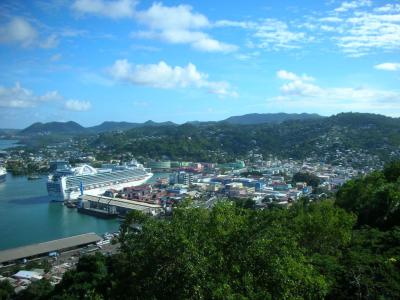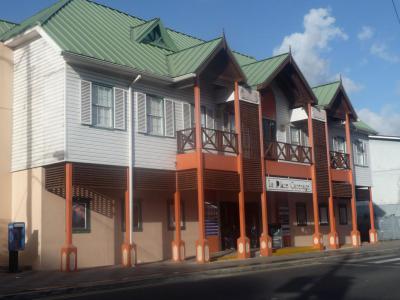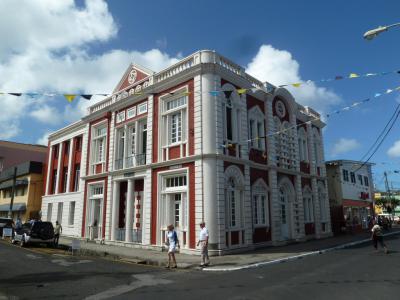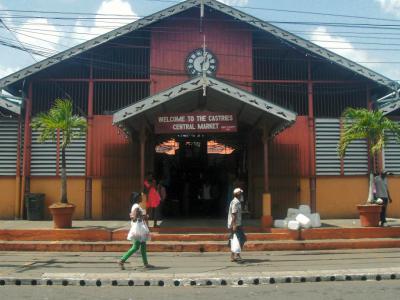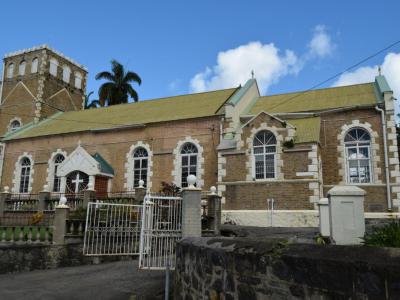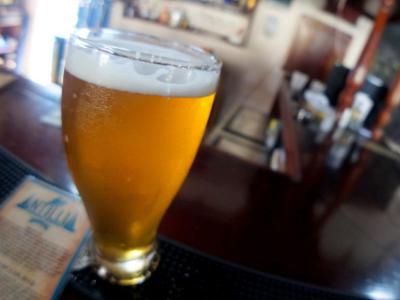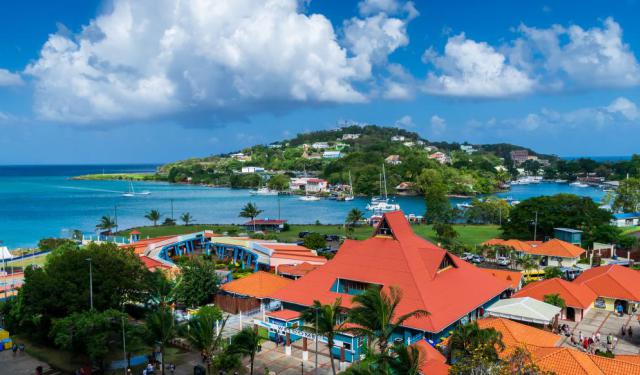
Castries Introduction Walking Tour (Self Guided), Castries
Welcome to Castries, the vibrant capital of Saint Lucia, a mesmerizing gem of the Caribbean! A major port of call for cruise ships on the island, Castries offers a colorful slice of Saint Lucian life, comprising historic landmarks, thrilling adventures, and picturesque golden beaches.
The town was founded by the French in 1650 as Carenage. In 1756, it was renamed after Marquis Charles de Castries, the French Naval Minister, thus marking its evolution as a strategic harbor city.
With Castries' deep-sea port, vital for large warships, and its extensive sugar production, the island became a target for British interest, leading to frequent conflicts between England and France, resulting in Castries changing hands several times. The island's strategic value was underscored by discussions of exchanging Saint Lucia for French Canada, while the fort of Morne Fortuné near Castries served as a defense against potential attacks. Britain's final control over Saint Lucia was established in 1814, leading to the development of Castries as the main seaport in the region.
Throughout its history, Castries endured several fires. The most recent and catastrophic one, the Great Castries Fire of 1948, razed 80% of its buildings, prompting a reconstruction with modern urban infrastructure. Following Saint Lucia's independence in 1979, Castries emerged as the capital of the newly formed nation.
One of the focal points of Castries is the La Place Carenage Cruise Port Terminal, a bustling hub where visitors disembark to explore the city. The adjacent La Place Carenage plaza offers a delightful array of shops, restaurants, and entertainment options.
For those seeking intellectual nourishment, the Central Library, housed in a historic architectural gem, boasts a rich literary heritage, while the nearby Derek Walcott Square honors the Nobel laureate poet and playwright who hails from Saint Lucia.
Religious landmarks also adorn the cityscape including the Catholic Cathedral Basilica of the Immaculate Conception and the elegant Holy Trinity Anglican Church.
While in Castries, take a stroll through the vibrant Castries Market and Vendor's Arcade, where the sights, sounds, and scents of local life tantalize the senses. Meanwhile, Duty Free Pointe Seraphine offers a shopping haven for those seeking souvenirs and luxury goods.
After a day of exploration, unwind at the Antillia Brewing Company Bar, where you can savor locally crafted brews amidst convivial company.
Castries – where adventure meets tranquility – awaits your discovery! Whether you're captivated by history and culture, or simply seeking relaxation, this enchanting city will give you an experience well worth remembering!
The town was founded by the French in 1650 as Carenage. In 1756, it was renamed after Marquis Charles de Castries, the French Naval Minister, thus marking its evolution as a strategic harbor city.
With Castries' deep-sea port, vital for large warships, and its extensive sugar production, the island became a target for British interest, leading to frequent conflicts between England and France, resulting in Castries changing hands several times. The island's strategic value was underscored by discussions of exchanging Saint Lucia for French Canada, while the fort of Morne Fortuné near Castries served as a defense against potential attacks. Britain's final control over Saint Lucia was established in 1814, leading to the development of Castries as the main seaport in the region.
Throughout its history, Castries endured several fires. The most recent and catastrophic one, the Great Castries Fire of 1948, razed 80% of its buildings, prompting a reconstruction with modern urban infrastructure. Following Saint Lucia's independence in 1979, Castries emerged as the capital of the newly formed nation.
One of the focal points of Castries is the La Place Carenage Cruise Port Terminal, a bustling hub where visitors disembark to explore the city. The adjacent La Place Carenage plaza offers a delightful array of shops, restaurants, and entertainment options.
For those seeking intellectual nourishment, the Central Library, housed in a historic architectural gem, boasts a rich literary heritage, while the nearby Derek Walcott Square honors the Nobel laureate poet and playwright who hails from Saint Lucia.
Religious landmarks also adorn the cityscape including the Catholic Cathedral Basilica of the Immaculate Conception and the elegant Holy Trinity Anglican Church.
While in Castries, take a stroll through the vibrant Castries Market and Vendor's Arcade, where the sights, sounds, and scents of local life tantalize the senses. Meanwhile, Duty Free Pointe Seraphine offers a shopping haven for those seeking souvenirs and luxury goods.
After a day of exploration, unwind at the Antillia Brewing Company Bar, where you can savor locally crafted brews amidst convivial company.
Castries – where adventure meets tranquility – awaits your discovery! Whether you're captivated by history and culture, or simply seeking relaxation, this enchanting city will give you an experience well worth remembering!
How it works: Download the app "GPSmyCity: Walks in 1K+ Cities" from Apple App Store or Google Play Store to your mobile phone or tablet. The app turns your mobile device into a personal tour guide and its built-in GPS navigation functions guide you from one tour stop to next. The app works offline, so no data plan is needed when traveling abroad.
Castries Introduction Walking Tour Map
Guide Name: Castries Introduction Walking Tour
Guide Location: St Lucia » Castries (See other walking tours in Castries)
Guide Type: Self-guided Walking Tour (Sightseeing)
# of Attractions: 9
Tour Duration: 2 Hour(s)
Travel Distance: 2.7 Km or 1.7 Miles
Author: nataly
Sight(s) Featured in This Guide:
Guide Location: St Lucia » Castries (See other walking tours in Castries)
Guide Type: Self-guided Walking Tour (Sightseeing)
# of Attractions: 9
Tour Duration: 2 Hour(s)
Travel Distance: 2.7 Km or 1.7 Miles
Author: nataly
Sight(s) Featured in This Guide:
- La Place Carenage Cruise Port Terminal
- La Place Carenage
- Central Library
- Derek Walcott Square
- Cathedral Basilica of the Immaculate Conception
- Castries Market and Vendor's Arcade
- Holy Trinity Anglican Church
- Duty Free Pointe Seraphine
- Antillia Brewing Company Bar
1) La Place Carenage Cruise Port Terminal
Saint Lucia's main cruise port boasts two primary piers and terminals, each offering unique experiences for arriving passengers. La Place Carenage Cruise Port Terminal is situated downtown, while the Pointe Seraphine Cruise Port Terminal lies on the northern side of the bay.
Although the bay is spacious enough to accommodate large vessels, mega cruise ships such as the Queen Mary II may anchor outside the bay due to their size. Passengers from these majestic liners are ferried to La Place Carenage Cruise Terminal aboard tender boats, ensuring seamless access to the terminal's facilities and amenities.
Situated right in downtown Castries, La Place Carenage Cruise Port Terminal provides easy access to the heart of the island's cultural and commercial center. Visitors disembarking at the terminal are greeted by the lively atmosphere of Castries, with its colorful streets, bustling markets, and historic landmarks.
Within walking distance of the terminal, travelers will find an array of attractions and points of interest. From the vibrant Castries Market to the iconic Derek Walcott Square, there's no shortage of sights to explore just steps away from the cruise port. Visitors can also stroll along the waterfront promenade, enjoying picturesque views of the bay and surrounding landscape.
La Place Carenage Cruise Port Terminal caters to the needs of cruise ship passengers with a range of amenities and services. Еhe terminal features cafés, bars, and restaurants where visitors can indulge in delicious cuisine and refreshing beverages.
Although the bay is spacious enough to accommodate large vessels, mega cruise ships such as the Queen Mary II may anchor outside the bay due to their size. Passengers from these majestic liners are ferried to La Place Carenage Cruise Terminal aboard tender boats, ensuring seamless access to the terminal's facilities and amenities.
Situated right in downtown Castries, La Place Carenage Cruise Port Terminal provides easy access to the heart of the island's cultural and commercial center. Visitors disembarking at the terminal are greeted by the lively atmosphere of Castries, with its colorful streets, bustling markets, and historic landmarks.
Within walking distance of the terminal, travelers will find an array of attractions and points of interest. From the vibrant Castries Market to the iconic Derek Walcott Square, there's no shortage of sights to explore just steps away from the cruise port. Visitors can also stroll along the waterfront promenade, enjoying picturesque views of the bay and surrounding landscape.
La Place Carenage Cruise Port Terminal caters to the needs of cruise ship passengers with a range of amenities and services. Еhe terminal features cafés, bars, and restaurants where visitors can indulge in delicious cuisine and refreshing beverages.
2) La Place Carenage
Situated on the south side of the harbor near the pier and markets, La Place Carenage comes alive with activity whenever a cruise ship docks in port. It boasts a diverse array of shops, offering everything from luxury goods to locally crafted souvenirs and artworks. Whether you're in search of high-end fashion, exquisite jewelry, or unique gifts to commemorate your visit to Saint Lucia, the mall has something for everyone. From indigenous crafts to flavorful spices and artisanal goods, La Place Carenage allows you to immerse yourself in the rich culture and heritage of Saint Lucia.
After a day of shopping, indulge your taste buds at one of the mall's dining establishments. Whether you're craving local Caribbean cuisine or international fare, you'll find a variety of culinary options to satisfy your appetite. Enjoy a leisurely meal or grab a quick bite to eat before continuing your exploration of Castries.
La Place Carenage isn't just about shopping and dining—it's also a hub of entertainment. From live music performances to cultural events and art exhibitions, the mall offers a vibrant atmosphere where visitors can immerse themselves in the dynamic energy of Saint Lucia.
After a day of shopping, indulge your taste buds at one of the mall's dining establishments. Whether you're craving local Caribbean cuisine or international fare, you'll find a variety of culinary options to satisfy your appetite. Enjoy a leisurely meal or grab a quick bite to eat before continuing your exploration of Castries.
La Place Carenage isn't just about shopping and dining—it's also a hub of entertainment. From live music performances to cultural events and art exhibitions, the mall offers a vibrant atmosphere where visitors can immerse themselves in the dynamic energy of Saint Lucia.
3) Central Library
The Central Library is a bustling hub of activity and culture. Its strategic position makes it easily accessible to residents and visitors alike, serving as a focal point for intellectual engagement and community interaction.
The library's building, a two-story structure dating back to the late 19th century, exudes architectural charm and grandeur. Adorned with multiple windows of various shapes and sizes, framed in stone between columns reminiscent of Greek architecture, the Central Library is a visual delight that commands attention.
Castries boasts a rich literary heritage, proudly claiming two Nobel laureates among its native sons. Arthur Lewis, born in Castries, was awarded the Nobel Memorial Prize in Economics in 1979, while Derek Walcott, another Castries native, received the Nobel Prize for Literature in 1992. Their contributions to academia and the arts have left an indelible mark on the city's cultural landscape.
Beyond serving as a repository of books and knowledge, the Central Library plays a vital role in fostering community engagement and lifelong learning. Through its diverse programs, workshops, and events, the library encourages intellectual curiosity, promotes literacy, and nurtures a love of reading among individuals of all ages.
The library's building, a two-story structure dating back to the late 19th century, exudes architectural charm and grandeur. Adorned with multiple windows of various shapes and sizes, framed in stone between columns reminiscent of Greek architecture, the Central Library is a visual delight that commands attention.
Castries boasts a rich literary heritage, proudly claiming two Nobel laureates among its native sons. Arthur Lewis, born in Castries, was awarded the Nobel Memorial Prize in Economics in 1979, while Derek Walcott, another Castries native, received the Nobel Prize for Literature in 1992. Their contributions to academia and the arts have left an indelible mark on the city's cultural landscape.
Beyond serving as a repository of books and knowledge, the Central Library plays a vital role in fostering community engagement and lifelong learning. Through its diverse programs, workshops, and events, the library encourages intellectual curiosity, promotes literacy, and nurtures a love of reading among individuals of all ages.
4) Derek Walcott Square (must see)
Formerly known as Columbus Square, Derek Walcott Square has undergone several name changes reflective of its evolving identity. Initially named Place d'Armes and later Promenade Square, it was renamed in honor of Nobel laureate Derek Walcott in 1993—a fitting tribute to one of Saint Lucia's most celebrated literary figures.
A placard commemorating Sir Derek Walcott's literary achievements adorns the square, serving as a testament to his profound impact on the world of literature and the cultural legacy he has left behind. As a Nobel laureate, Walcott's contributions to poetry and theater have earned him international acclaim and reverence.
Surrounded by bustling thoroughfares and architectural landmarks such as the Cathedral of the Immaculate Conception and the Castries Central Library, the square serves as a focal point for both locals and visitors. Despite its central location and proximity to urban activity, Derek Walcott Square offers a serene and peaceful retreat from the bustle of city life. Lush greenery, manicured lawns, and shaded pathways create an inviting ambiance, inviting visitors to relax, unwind, and soak in the natural beauty of their surroundings.
One of the square's most beloved features is the majestic "Massav" tree, affectionately known as the "Samaan" tree by locals. Estimated to be over 400 years old, this towering specimen stands as a symbol of resilience and endurance, offering shade and shelter to visitors seeking respite from the Caribbean sun.
A placard commemorating Sir Derek Walcott's literary achievements adorns the square, serving as a testament to his profound impact on the world of literature and the cultural legacy he has left behind. As a Nobel laureate, Walcott's contributions to poetry and theater have earned him international acclaim and reverence.
Surrounded by bustling thoroughfares and architectural landmarks such as the Cathedral of the Immaculate Conception and the Castries Central Library, the square serves as a focal point for both locals and visitors. Despite its central location and proximity to urban activity, Derek Walcott Square offers a serene and peaceful retreat from the bustle of city life. Lush greenery, manicured lawns, and shaded pathways create an inviting ambiance, inviting visitors to relax, unwind, and soak in the natural beauty of their surroundings.
One of the square's most beloved features is the majestic "Massav" tree, affectionately known as the "Samaan" tree by locals. Estimated to be over 400 years old, this towering specimen stands as a symbol of resilience and endurance, offering shade and shelter to visitors seeking respite from the Caribbean sun.
5) Cathedral Basilica of the Immaculate Conception (must see)
The Cathedral Basilica of the Immaculate Conception is an impressive religious edifice that dominates the skyline of Castries. Named after Mary, the mother of Jesus, under her title of Our Lady of the Immaculate Conception, the cathedral is celebrated for its remarkable design, making it a prominent landmark in the Caribbean region. With dimensions measuring 61 meters (200 feet) in length and 30 meters (100 feet) in width, the cathedral holds the distinction of being the largest in the Caribbean. Its imposing size and striking architecture command attention and reverence from visitors and locals alike.
The cathedral's official foundation was laid in 1894, marking the beginning of an ambitious construction project. Despite facing challenges such as muddy ground and difficult conditions, the cathedral gradually took shape over the following years, with completion achieved by 1897.
Stepping inside the Cathedral Basilica of the Immaculate Conception reveals a vibrant and eclectic interior. Bright Rasta tones of red, green, and yellow adorn the walls, creating a visually stunning ambiance. Trompe l’oeil columns and intricate biblical scenes add to the cathedral's unique charm and character. One of the most significant features of the cathedral is the depiction of Saint Lucia, the island's patron saint, positioned directly above the altar.
As a cherished cultural icon of Saint Lucia, the cathedral welcomes countless visitors, including those arriving on cruise ships eager to explore the island's treasures.
The cathedral's official foundation was laid in 1894, marking the beginning of an ambitious construction project. Despite facing challenges such as muddy ground and difficult conditions, the cathedral gradually took shape over the following years, with completion achieved by 1897.
Stepping inside the Cathedral Basilica of the Immaculate Conception reveals a vibrant and eclectic interior. Bright Rasta tones of red, green, and yellow adorn the walls, creating a visually stunning ambiance. Trompe l’oeil columns and intricate biblical scenes add to the cathedral's unique charm and character. One of the most significant features of the cathedral is the depiction of Saint Lucia, the island's patron saint, positioned directly above the altar.
As a cherished cultural icon of Saint Lucia, the cathedral welcomes countless visitors, including those arriving on cruise ships eager to explore the island's treasures.
6) Castries Market and Vendor's Arcade (must see)
The Castries Market and Vendor's Arcade boast the distinction of being the largest open-air market in Castries. With its central location and expansive layout, it serves as a vibrant marketplace teeming with activity and local flavor. Constructed in 1891 by building engineers Bruce & Still Ltd. of Liverpool, the market has a storied past steeped in tradition. Officially opened by Sir Charles Bruce on July 2, 1894, it was originally established to enhance the town's aesthetic appeal while providing a centralized venue for commerce.
With over 300 regular vendors and an additional hundred or more local sellers on market days, the Castries Market offers a diverse array of goods and products. From fresh produce and spices to crafts and dry goods, visitors can explore a treasure trove of offerings reflecting the island's vibrant culture.
While the market's offerings have evolved over time, it remains a vital source for purchasing a wide variety of goods. While fish is no longer sold and meat isn't slaughtered on-site, the market continues to serve as a central hub for acquiring natural produce and goods sourced from local vendors.
In response to increasing congestion on the sidewalks, the Castries City Council introduced the Vendor's Arcade annex in 1996. This annex provides an additional space for vendors to showcase their wares, offering tourists the opportunity to sample local cuisine, purchase frozen meat, or acquire handmade crafts directly from artisans.
Within the Vendor's Arcade, visitors can immerse themselves in the flavors of Saint Lucian cuisine, sampling dishes from local restaurants and vendors. Additionally, the arcade serves as a platform for artisans to showcase their craftsmanship, with a wide selection of locally made crafts available for purchase.
With over 300 regular vendors and an additional hundred or more local sellers on market days, the Castries Market offers a diverse array of goods and products. From fresh produce and spices to crafts and dry goods, visitors can explore a treasure trove of offerings reflecting the island's vibrant culture.
While the market's offerings have evolved over time, it remains a vital source for purchasing a wide variety of goods. While fish is no longer sold and meat isn't slaughtered on-site, the market continues to serve as a central hub for acquiring natural produce and goods sourced from local vendors.
In response to increasing congestion on the sidewalks, the Castries City Council introduced the Vendor's Arcade annex in 1996. This annex provides an additional space for vendors to showcase their wares, offering tourists the opportunity to sample local cuisine, purchase frozen meat, or acquire handmade crafts directly from artisans.
Within the Vendor's Arcade, visitors can immerse themselves in the flavors of Saint Lucian cuisine, sampling dishes from local restaurants and vendors. Additionally, the arcade serves as a platform for artisans to showcase their craftsmanship, with a wide selection of locally made crafts available for purchase.
7) Holy Trinity Anglican Church
The Holy Trinity Anglican Church is an integral part of the Anglican Diocese of the Windward Islands, which is one of eight dioceses within the Province of the West Indies. Construction of the Holy Trinity Anglican Church commenced in 1830 and was completed in 1832. Originally built in a different style, the present brick church was erected in 1894 in the Romanesque Revival architectural style, under the design expertise of architect S.T. Wenbork.
The church's façade features distinctive Romanesque architectural elements, characterized by a white stone Romanesque arch framing the main entrance. A towering spire adorned with louvered windows and rounded arches ascends above the entrance, creating a striking focal point. The tower of the Holy Trinity Anglican Church boasts intricate details, including a staircase leading to a door on the second level and louvered windows with rounded tops adorning each side. A line of stones at the top of the tower forms a crenellated roof, adding to its grandeur.
The north side of the church features large Romanesque style windows framed by white stone blocks, while the south side includes an auxiliary entrance pavilion and additional Romanesque windows. Both sides showcase the meticulous craftsmanship and attention to detail prevalent in the church's design. A two-story addition at the back of the church enhances its functionality and architectural appeal, providing additional space while maintaining the integrity of the original structure.
Beyond its architectural splendor, the Holy Trinity Anglican Church holds significant historical importance as a symbol of Saint Lucia's colonial past and religious heritage.
The church's façade features distinctive Romanesque architectural elements, characterized by a white stone Romanesque arch framing the main entrance. A towering spire adorned with louvered windows and rounded arches ascends above the entrance, creating a striking focal point. The tower of the Holy Trinity Anglican Church boasts intricate details, including a staircase leading to a door on the second level and louvered windows with rounded tops adorning each side. A line of stones at the top of the tower forms a crenellated roof, adding to its grandeur.
The north side of the church features large Romanesque style windows framed by white stone blocks, while the south side includes an auxiliary entrance pavilion and additional Romanesque windows. Both sides showcase the meticulous craftsmanship and attention to detail prevalent in the church's design. A two-story addition at the back of the church enhances its functionality and architectural appeal, providing additional space while maintaining the integrity of the original structure.
Beyond its architectural splendor, the Holy Trinity Anglican Church holds significant historical importance as a symbol of Saint Lucia's colonial past and religious heritage.
8) Duty Free Pointe Seraphine (must see)
Duty Free Pointe Seraphine enjoys a prime location, just five minutes away from both the city centre and the George F. L. Charles airport. Its proximity to the cruise ship terminal makes it easily accessible for visitors disembarking from cruise ships.
With over forty stores to choose from, Duty Free Pointe Seraphine caters to every shopper's needs. Travelers seeking duty-free and tax-free items such as jewelry, watches, liquor, fragrances, electronics, and souvenirs will find an extensive selection to explore.
Beyond shopping, visitors can indulge in a range of dining options, from local Caribbean cuisine to international fare, at various restaurants within the complex. The Pink Papaya Restaurant, a bustling favorite among visitors and employees alike, offers a delightful culinary experience. Additionally, visitors can relax and soak up the surroundings while sampling delicious local Piton beer or enjoying complimentary Wi-Fi services.
For those seeking adventure, Duty Free Pointe Seraphine serves as a launching point for various land and boat tours. The Hibiscus Trolley Train offers a stylish tour of the surrounding area, including stops at Castries and Vigie Beach for swimming and lunch.
With over forty stores to choose from, Duty Free Pointe Seraphine caters to every shopper's needs. Travelers seeking duty-free and tax-free items such as jewelry, watches, liquor, fragrances, electronics, and souvenirs will find an extensive selection to explore.
Beyond shopping, visitors can indulge in a range of dining options, from local Caribbean cuisine to international fare, at various restaurants within the complex. The Pink Papaya Restaurant, a bustling favorite among visitors and employees alike, offers a delightful culinary experience. Additionally, visitors can relax and soak up the surroundings while sampling delicious local Piton beer or enjoying complimentary Wi-Fi services.
For those seeking adventure, Duty Free Pointe Seraphine serves as a launching point for various land and boat tours. The Hibiscus Trolley Train offers a stylish tour of the surrounding area, including stops at Castries and Vigie Beach for swimming and lunch.
9) Antillia Brewing Company Bar
Antillia craft beers are a testament to the rich history, vibrant culture, and natural bounty of Saint Lucia. Established in 2015, Antillia Brewing Company holds the distinction of being the only craft brewery in Saint Lucia. Renowned for brewing the finest artisanal ales in the Caribbean, Antillia has earned recognition for its commitment to quality and innovation.
While Antillia produces traditional ales and stouts, its specialty lies in brewing with fresh, local ingredients. Each brew is crafted with meticulous attention to detail, often incorporating elements deeply rooted in the history and culture of the islands.
Antillia Brewing Company maintains a state-of-the-art production facility in Odsan, Castries, where its expert brewers work tirelessly to create exceptional brews. Additionally, visitors can experience the brewery's offerings firsthand at its beer garden and retail center at Point Seraphine.
While Antillia produces traditional ales and stouts, its specialty lies in brewing with fresh, local ingredients. Each brew is crafted with meticulous attention to detail, often incorporating elements deeply rooted in the history and culture of the islands.
Antillia Brewing Company maintains a state-of-the-art production facility in Odsan, Castries, where its expert brewers work tirelessly to create exceptional brews. Additionally, visitors can experience the brewery's offerings firsthand at its beer garden and retail center at Point Seraphine.
The Most Popular Cities
/ view all
